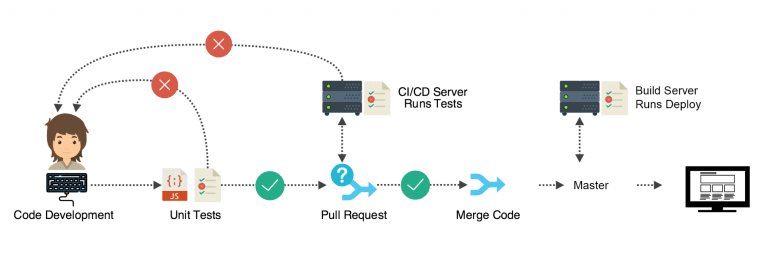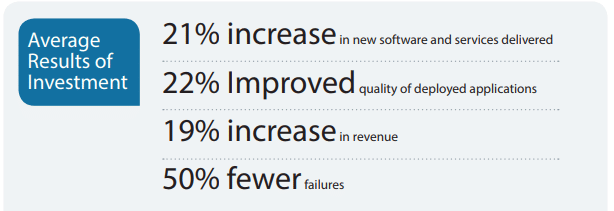The CI/CD pipeline is one of the fundamental practices for DevOps implementation and it bridges the gap between development and operations teams. It is the best practice for DevOps teams to deliver code more frequently and reliably. It is the backbone of the modern development environment. Teams can automate the complete build, test and deployment-related tasks using CI/CD. You will get to know in detail about CI/CD and its working in this blog.
Earlier teams were following the waterfall model, then agile and now it’s DevOps. DevOps has lead to new methods of Continuous Integration, Delivery, and Deployment. Conventional SDLC methods are becoming obsolete. Enterprises which used to release code monthly, quarterly or even annually are now releasing the code on a daily or weekly basis following the DevOps approach. Consumers need not download the updates of the software they are using since the SAAS has come into power. They don’t even realize sometimes when their software is getting an update.
Continuous Integration takes care of integrating the work done by individual developers into a repository. Following the DevOps approach, this is done several times in a day to detect the bugs in the initial phases itself. It increases collaboration among development teams. Generally, the application which is working in the local environment stops working in the production. CI/CD helps in avoiding these sudden shocks by enabling continuous testing along with the development. It involves the automation of each step of a release process. Continuous Deployment enables teams to automatically deploy the changes to the production without any manual intervention.

Continuous Integration (CI)
Earlier, every developer used to do their development related tasks independently and other members of the team were unaware of what their colleague is doing. Using continuous integration, developers maintain their code at one place and integrate it into the main branch of the repository. Developers used to submit code at the end of the cycle, which lead to more bugs and testing related issues. Integration costs can be reduced using CI as the developers integrate their code from the very beginning. Following this approach, the conflicts can be resolved earlier which will save a lot of time and cost. The main aim of CI is to make everyday development tasks simple that can save time and reduce costs.
Continuous delivery comes next to the continuous integration which makes the software delivery process easy. Using continuous delivery code can be safely deployed to the production. Code at this stage can be deployed on the spot. There is no sense of urgency and special late night shifts for releasing the code to the production. With a CD it becomes the routine event. CD is majorly dependent on the deployment pipeline and teams can automate the testing and deployment processes.
After failing the critical test in the deployment pipeline, developers can be notified about the issues. If everything goes well then the pipeline will deploy the code to the production-like environment. Since the build, deployment, and environment are all tested together, the resulted code is deployable to the production environment.
Continuous Deployment (CD)
After continuous delivery, the software build can be automatically deployed to the production if it passes all the tests. There is no manual intervention, and no one is required to decide when the code is ready to get into production and what needs to be sent to the production. The last step in the CI/CD pipeline will automatically publish the changes to the production. It can save a lot of time, money and effort of the Dev and Ops teams.
Continuous deployments enable teams to engage with customers and get their feedback from time to time. Any changes required or any defects found within the application can be handled promptly without devoting more time at later stages. Customers also get to know the progress of their projects on a real-time basis. They can keep checking whether the development teams are working according to the requirements shared by them.
There are many CI/CD tools like Jenkins, available in the market that can integrate with the developer tools like Github and Bitbucket. But using these tools you need to manage different applications for each use case. With VegaStack you need not use different tools to achieve different results. It is a single secured application addressing all your needs related to SDLC.
Testing automation
Testing automation help QA engineers in defining, executing and automating various types of tests. These tests can help the developers in accessing the performance of their application. It tells them whether the application build passes or fails. These automated tests help in functionality testing after every sprint and regression testing for complete software. The regressions tests then generate the report of the code changes that got failed.
To save time developers can run regression tests on their local environments before committing the code to the version control repository. This practice ensures that only the bug-free code is reaching the version control system.
Automation in testing doesn’t just end at the regression tests. All other tests like static code analysis, security testing, API testing etc. can also be automated. The main idea is to trigger these tests through the command line, webhook or any different web service which can give the result of success or failure.
Business Benefits of CI/CD
There are many benefits associated with CI/CD implementation:
Improvement in Collaboration and Quality
Implementing continuous integration, developers do frequent code commits which makes it easier to identify defects and quality related issues. On the other hand, following the conventional methods force developers to do the same task again and again. This ultimately affects their efficiency and brings less return on investment. Continuous integration leads to lesser merge conflicts due to the shorter commit cycles which ultimately save a lot of business hours which can be spent on creating more new interesting features.
The first step towards continuous integration is configuring the version control system. Despite frequent code commits, bugs are resolved on both short and longer time frames. There are different techniques to control what features are ready for deployment to production and can be made public for the users.
Version-controlling using branches is one such technique. The branching strategy set rules over how new code should be handled. It can help in managing the new code into different branches and merge to the main branch once the code is ready for testing and deployment. If a feature requires long development cycles then it can be developed in a separate branch and later can be merged with the main one. This branching approach works very well but can be difficult to handle in case of simultaneous development of many different features.
Another interesting technique for managing features is feature flags. It enables teams to turn on or a feature at runtime. Features that are still in the development stage can be pushed to the production but can be turned off until they are ready for the production environment and to be used by the users. Using CI the build process can be automated. The software, database, and other components can be packaged for the automated builds.
CI not only creates the automated builds but can also help in executing unit tests and other software related testing. These automating testing features assures developers that their code is not breaking any existing unit tests.
Developers can trigger builds anytime using CI/CD. Code commits can trigger the builds in the version control system or on a defined schedule. Teams can set there build schedules according to their team size and deployment frequency. Planning ahead is the best practice to avoid any delays in the deployments and releasing new features.

CI/CD Enables Frequent Deployments
CI help in packaging the software builds and notify developers if any of their changes lead to failed unit tests. CD delivers changes to the infrastructure either staging or production and executes the additional tests.
These pipelines are designed for organizations that need a reliable delivery process and frequent code releases. Many people have the misconception that these automation scripts takes forever to get configured which is not so. It is just the one-time effort to standardize builds, tests and automate deployments. After the successful implementation of these automation scripts, developers need not deliver any extra time on knowing the system details for application delivery. They can now easily focus on their main task i.e developing new features.
CI/CD is a DevOps practice as it bridges the gap between developers who want to release code frequently and Ops team that want stable applications. DevOps automation allows developers to make frequent commits and releases. Tasks are much easier for the Ops team because the testing is done in the delivery process itself.
CI/CD implementation requires dev and ops team to collaborate on technologies and practices. Teams need to be on the same page to realize the benefits and experience the power of automation.
Faster Software Builds
CI/CD results in faster build and quick results. It helps in providing real-time feedback from the user and fixes any bugs or issues at the beginning itself without wasting time at the later stages. Consistent reviews help in product refinement and satisfy the requirements of the end user. Using this approach user and the developer stays on the same page and developers don’t waste their time on creating any feature that is not required.
With this automation, teams can receive quicker test results for their product build and see their product deployed faster.
Better Time-to-Market
Faster release and quick deployments help in getting your app to the market in time. It can not only lead to better client engagement but also increase profits. Hence, better time to market will help you in staying relevant to the drastically changing markets and affect your ROI.
With reduced time-to-market, enterprises can be confident that their software will release well before market changes, their competitors or user’s ever-rising demands.
Improvements to Code Quality
CI helps in building high-quality apps. It allows developers to collaborate and integrate their code into a single code repository. Using this approach developers don’t work in isolation rather share their build among themselves which leads to a decrease in integration costs. Shorter release cycle and better collaboration enable developers to resolve conflicts in real-time without any delay.
However, these fixes rely heavily on manual processes and require manual intervention to ensure that new code does not bring in new bugs, issues or break the existing code. To minimize these issues, CI supports testing automation. Not only does this save on time but requires minimal human intervention, thus reducing the chances of system failure.
Developer Efficiency
By incorporating CI, enterprise development team becomes sounder and bankable and the cost of their software projects comes down drastically.
The main aim of CI is to refine the integration process, and break it down into small, simple, daily development tasks, to help reduce the build costs and detect and resolve issues, bugs or defects early in the software lifecycle.
Supporting this is the continuous delivery (CD) process, where the software delivery process is further automated to facilitate easy deployments into production at any time. Thus, an efficient continuous delivery process displays a codebase that is easily deployable. Hence, the software is released on schedule. Owing to this benefit, enterprise teams would effectively be able to execute daily development tasks and release software builds at any time.
Also, success in CI is also dependent on teams responsiveness to change – readiness, frequent software builds and iterations, and fixing bugs in real time.
In a nutshell, by adopting the CI/CD approach, teams are assured to gain the following:
- Detect issues in software builds faster and, therefore, facilitating quicker resolutions
- Customer involvement and feedback during the development cycle can lead to usability improvements
- Quick releases deliver software on time with faster time to market
- Organizations can showcase their capabilities in the market by adopting better approaches like CI/Cd for their development processes
- Frequent releases using CD are easy and saves time
- Complete visibility of the development process in real-time
Conclusion
CI/CD is an integral part of software development and deployment process. It can be beneficial for small teams as well as large enterprises. It helps in doing regular changes, getting feedbacks and doing secured deployments. The benefits associated with CI/CD doesn’t limit to only the businesses but also impact the other stakeholders, like product owners, dev and ops teams and the end users.
Whenever there is any new implementation it has to go through cultural discourse to figure out the pros and cons associated with its adoption. The same applies to the adoption of CI/CD in the software development processes. Many times developers and management have a misunderstanding about the implementation of CI/CD. They consider it to be as an additional task. But after its implementation, it can lead to big advantages such as reduced costs and increased ROI.
In addition, with automation, businesses will be able to invest more time in building products and features rather than engaging in the same repetitive tasks.
Therefore, CI/CD methodology helps in building and improving the applications with faster time to market and better user experience. Automation in software development streamlines the processes and the complete cycle which helps in building better and more consistent apps.


